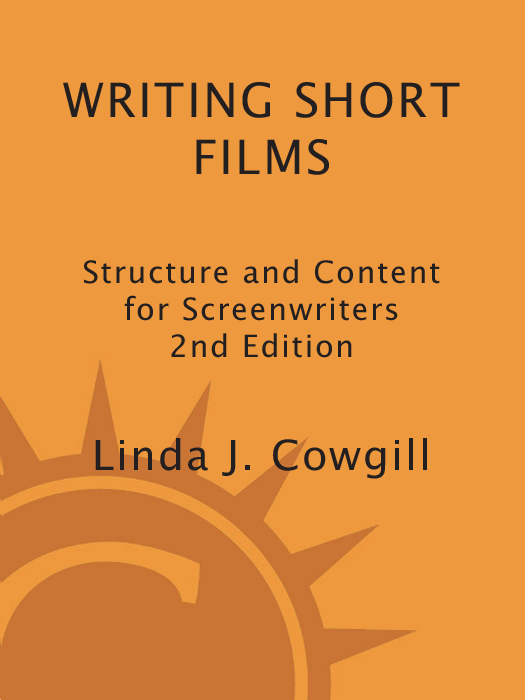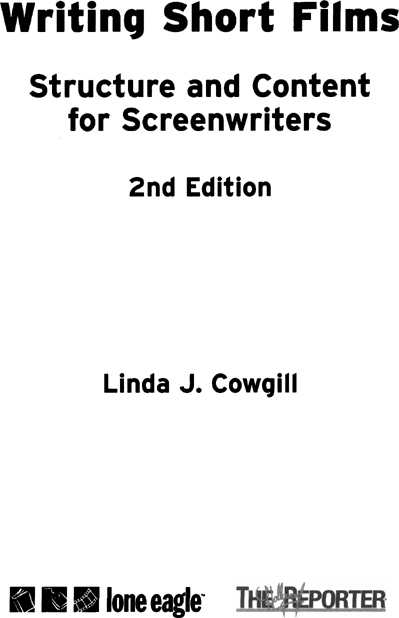CONTENTS
PART ONE -
PART TWO -
PART THREE -
PART FOUR -
APPENDICES
AFade In to Fade Out: Proper Screenplay Format
Acknowledgments
The new edition of Writing Short Films would not have been possible without the help of numerous people, who I am happy to thank here.
Jeff Black at Lone Eagle and Hollywood Creative Directory, whose encouragement and aid has been instrumental to keeping me focused and on track.
Joan Singleton and Beth Wetzel, for originally recognizing the value of this book and putting it into motion.
Hilary Ripps at Chanticleer Films and Bryan Gordon, for the use of the screenplay to Rays Male Heterosexual Dance Hall.
Michael Kelly, at Vidiots in Santa Monica, along with the owners: Cathy Tauber and Patty Polinger, for having such a great selection of short films on video.
Ed Carter and Fritz Herzog, at the Academy of Motion Picture Arts and Sciences, for help screening several Academy Award winning live action shorts.
Geoff Grode for starting me on this path at AFI, Richard DeBaun for helping me prepare, and Steve Sharon for being there all these years.
I have to thank my students at the Los Angeles Film School who have appreciated my ideas and allowed me to learn from them.
Introduction
Today in Hollywood its far easier to get an agent, producer or production executive to view a short film than it is to get them to read a feature length screenplay. (Short form screenplays go virtually unread at studios and agencies.) The reasons are obvious. It takes less time to watch a short film than to read a script, and if its good, its far more enjoyable.
If those words were true eight years ago when I first wrote Writing Short Films, they are even truer today. South Park creators, Trey Parker and Matt Stone, launched their careers with a short done as a video Christmas card for a Hollywood executive. Christopher Nolans short film Doodlebug announced a new talent. Stephen Daldrys short Eight got him ready for Billy Elliot. Joe Nussbaums George Lucas in Love introduced him to studio execs and landed him Sleepover. Billy Bob Thorton wrote and George Hickenlooper directed Some Folks Call It a Sling Blade, the film that preceded the feature Sling Blade. Tom DiCillo wrote and directed the short Living in Oblivion, and then found financing to turn it into a feature film. The list goes on.
The short film, whether made on a university campus or independently financed, continues to be a well-traveled road into the film business. Steven Spielberg, Martin Scorsese, Francis Ford Coppola, George Lucas, John Carpenter, to name a famous few, all started this way. Lucas and Carpenter expanded their student films into low-budget features; the others used short films as calling cards to production executives and producers who championed them and launched their careers. Sidney Sheinberg recognized Steven Spielbergs talent from his short film and hired the young director for an episode of Rod Serlings anthology series The Night Gallery.
These days short films are everywhere: on the internet, on television and in theaters at festivals specializing in shorts that are popping up all over the world. With low cost digital media, simple home DVD duplication and the internet, its never been easier to produce and distribute short films.
However, just because its easier to make a short and get it seen doesnt mean theres an ocean of great films out there waiting for you. The problem of story still exists. So while everyone is making shorts (from elementary school students to professional screenwriters aspiring to become directors), the search for good ones, great ones, the best ones continues because mastering story is still the essential art. Every other aspect of filmmaking in the narrative form exists to serve the story. If the story isnt sound, the film cant be. A film may be fantastic visually, but if the story doesnt work, the film wont serve you, the director, to the extent it should. Strong visual images are found on the reels of many cinematographers and editors; well-acted scenarios make up the reels of many actors. But your job as a filmmaker a screenwriter, director, producer, or some combination of all three is to deliver a film that makes sense as a story.
THE DESIGN OF THIS BOOK
The focus of Writing Short Films is on writing the screenplay for the synchronous sound narrative short film. This is not a manual on filmmaking, geared in any way toward production other than providing the best outline possible of principles and techniques for constructing the short screenplay. This book is designed specifically for those wanting to make a narrative-driven short film, and who recognize that before production can begin a completed script must be in hand. (Experimental, non-narrative films are not dealt with.) Though most of the examples I have selected derive from narrative sync sound shorts, these same concepts can be applied to non-sync sound short films. I use examples from Albert Lamorisses The Red Balloon and Robert Enricos Occurrence at Owl Creek, both essentially non-sync sound films, throughout this book. The reason is simple: even without a synchronized soundtrack, these films are story-driven.
Ive laid the book out in four sections. Part One introduces the concepts the beginning writer must know to develop an idea; provides an overview of screenplay structure for the short film; and covers the principles of plot. Part Two considers structure in depth the set-up, rising action and conclusion emphasizing the tools the screenwriter uses to construct a plot. Part Three covers the writing process, with discussions on scene construction, dialogue and subtext. The final section deals with ideas for keeping a story focused. Appendices cover information on proper screenplay format, computer screenwriting programs, and more information on the referenced films.
A major shortcoming Ive found in other books on writing the short screenplay is the lack of examples drawn from easily available sources. Without concrete examples to illustrate the principles of characterization, construction and theme, the discussion becomes elusive. The reader depends upon a description of events, sometimes problematic if the memory of the author fails him. Even if student screenplays are included in an appendix to the book, it is not the same as seeing a finished film.
I believe its more important to see a film than to read one. Wherever possible, I have tried to use examples from films that are on video, several of which can be found in major video chains, while others can be located in more eclectic stores, libraries or through outlets like NetFlix and Facets Media. Many are now turning up on the internet for viewing, or for purchase at Amazon.com or FacetsMedia.com. Internet sites such as iFilm.com, Atomfilms.com, TriggerStreet.com, BMWFilms.com and more, all have short films available for round the clock viewing.
The numbers of domestic and international film festivals increase annually, and short films make up growing portions of their programs. Each year Hollywood pays greater attention to the festivals, both as a source of new talent, and for short form product, which is in demand from major cable channels and those specializing in independent film. (The Sundance Channel, IFC, HBO and Showtime all acquire shorts for programming needs.) Many new filmmakers emerge from these forums, if not with production deals then often with interested agents, producers or production executives.


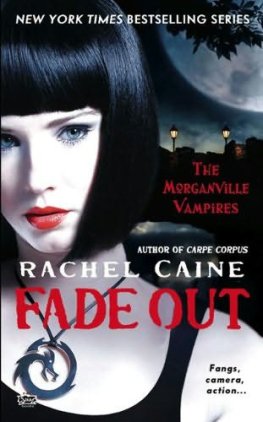
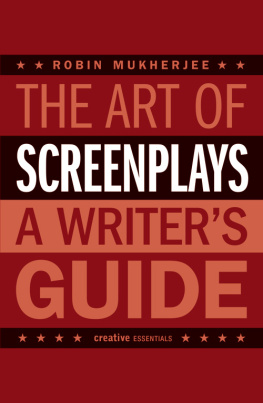


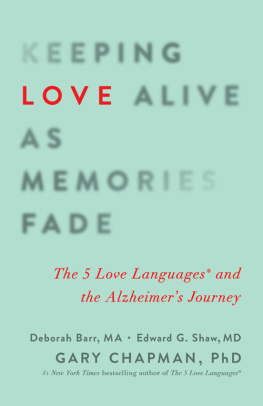
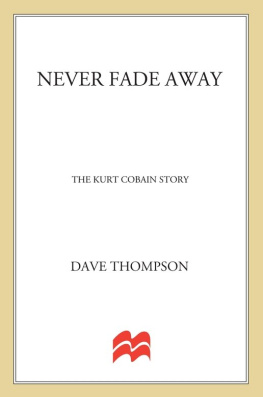
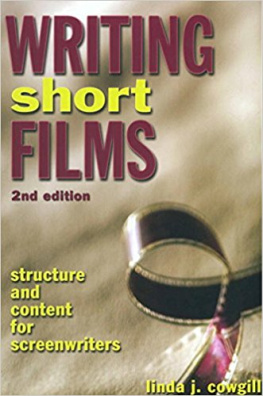
![Watt - The 90-day screenplay : [from concept to polish]](/uploads/posts/book/103527/thumbs/watt-the-90-day-screenplay-from-concept-to.jpg)
